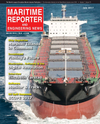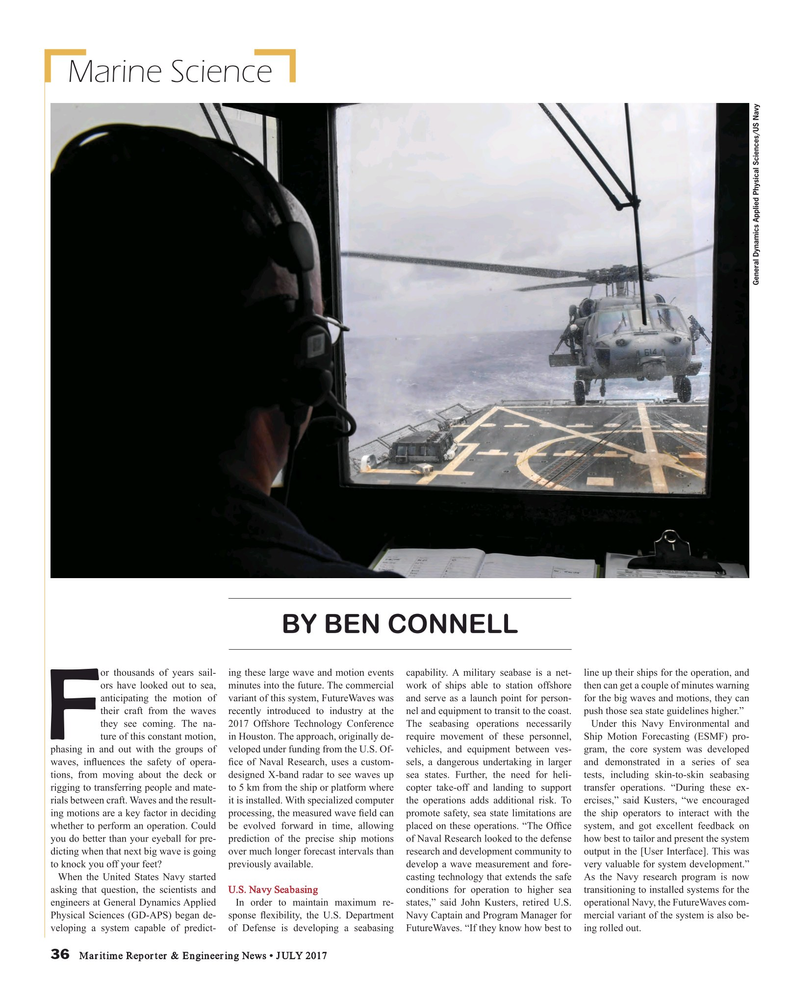
Page 36: of Maritime Reporter Magazine (July 2017)
The Marine Communications Edition
Read this page in Pdf, Flash or Html5 edition of July 2017 Maritime Reporter Magazine
Marine Science
General Dynamics Applied Physical Sciences/US Navy
BY BEN CONNELL or thousands of years sail- ing these large wave and motion events capability. A military seabase is a net- line up their ships for the operation, and ors have looked out to sea, minutes into the future. The commercial work of ships able to station offshore then can get a couple of minutes warning anticipating the motion of variant of this system, FutureWaves was and serve as a launch point for person- for the big waves and motions, they can their craft from the waves recently introduced to industry at the nel and equipment to transit to the coast. push those sea state guidelines higher.” they see coming. The na- 2017 Offshore Technology Conference The seabasing operations necessarily Under this Navy Environmental and
F ture of this constant motion, in Houston. The approach, originally de- require movement of these personnel, Ship Motion Forecasting (ESMF) pro- phasing in and out with the groups of veloped under funding from the U.S. Of- vehicles, and equipment between ves- gram, the core system was developed waves, in? uences the safety of opera- ? ce of Naval Research, uses a custom- sels, a dangerous undertaking in larger and demonstrated in a series of sea tions, from moving about the deck or designed X-band radar to see waves up sea states. Further, the need for heli- tests, including skin-to-skin seabasing rigging to transferring people and mate- to 5 km from the ship or platform where copter take-off and landing to support transfer operations. “During these ex- rials between craft. Waves and the result- it is installed. With specialized computer the operations adds additional risk. To ercises,” said Kusters, “we encouraged ing motions are a key factor in deciding processing, the measured wave ? eld can promote safety, sea state limitations are the ship operators to interact with the whether to perform an operation. Could be evolved forward in time, allowing placed on these operations. “The Of? ce system, and got excellent feedback on you do better than your eyeball for pre- prediction of the precise ship motions of Naval Research looked to the defense how best to tailor and present the system dicting when that next big wave is going over much longer forecast intervals than research and development community to output in the [User Interface]. This was to knock you off your feet? previously available. develop a wave measurement and fore- very valuable for system development.”
When the United States Navy started casting technology that extends the safe As the Navy research program is now asking that question, the scientists and U.S. Navy Seabasing conditions for operation to higher sea transitioning to installed systems for the engineers at General Dynamics Applied In order to maintain maximum re- states,” said John Kusters, retired U.S. operational Navy, the FutureWaves com-
Physical Sciences (GD-APS) began de- sponse ? exibility, the U.S. Department Navy Captain and Program Manager for mercial variant of the system is also be- veloping a system capable of predict- of Defense is developing a seabasing FutureWaves. “If they know how best to ing rolled out.
36 Maritime Reporter & Engineering News • JULY 2017
MR #7 (34-41).indd 36 MR #7 (34-41).indd 36 7/6/2017 12:35:39 PM7/6/2017 12:35:39 PM

 35
35

 37
37
